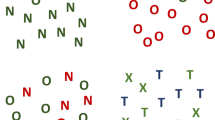Abstract
Previous studies have shown a lorazepam effect on visual perception. We tested whether this impairment resulted from a peripheral effect induced by benzodiazepines. A first experiment showed that a single dose of lorazepam induces an oculomotor imbalance without impairing visual acuity or accommodation. In a second experiment, we tested whether the impairment induced by lorazepam on visual perception still occurred in monocular vision. Subjects matched incomplete forms controlled on the spacing and alignment of their local contour elements. A reference object was first displayed and followed by two laterally displayed objects, a target and a distractor. The distractor was the mirror-reversed version of the target. Performance was impaired in the lorazepam group when the reference was an incomplete form with a spacing of 10.8' or 22.2' of arc. These results were not correlated with sedation. They confirm that lorazepam has a central deleterious effect on visual perception. A posthoc analysis also suggested that lorazepam-treated subjects used asymmetry in the stimuli as a compensatory strategy. This result is discussed in relation to previous hypotheses about the physiological mechanisms that determine the effects of lorazepam on visual perception.
Similar content being viewed by others
References
Beck J, Rosenfeld A, Ivry R (1989) Line segregation. Spatial Vision 4:75–101
Barlow HB, Reeves BC (1979) The versatility and absolute efficiency of detecting mirror symmetry in random dot displays. Vision Res 19:783–793
Bartram DJ (1976) Levels of picture coding in picture-picture comparison task. Mem Cogrit 4:593–602
Baylis GC, Driver J (1994) Parallel computation of symmetry but not repetition within single visual shapes. Vis Cogrit 1:377–400
Bond A, Lader M (1974) The use of analogue scales in rating subjective feelings. Br J Med Psychol 47:211–218
Boucart M, Humphreys G (1992) Global shape cannot be attended without object identification. J Exp Psychol [Hum Percept Perf] 18:785–806
Boucart M, Delord S, Giersch A (1994) The computation of contour information in complex objects. Perception (special issue) 23:399–409
Bruce VG, Morgan MJ (1975) Violations of symmetry and repetition in visual patterns. Perception 4:239–249
Dakin SC, Watt RJ (1994) Detection of bilateral symmetry using spatial filters. Spat Vis 8:393–413
Dobbins A, Zucker SW, Cynader MS (1989) Endstopping and curvature. Vision Res 29:1371–1387
Giersch A, Boucart M, Danion JM, Vidailhet P, Legrand F (1995) Effects of lorazepam on perceptual integration of visual forms in healthy volunteers. Psychopharmacology 119:105–114
Gregory RL (1972) Cognitive contours. Nature 238:51–52
Harris JP, Phillipson OT (1995) Effects of lorazepam on human contrast sensitivity. Psychopharmacology 117:379–384
Heidtger F, Rosenthaler L, von der Heydt R, Peterhans E, Kubler O (1992) Simulation of neural contour mechanisms: from simple to end-stopped cells. Vision Res 32:963–981
Hoffman DD, Richards WA (1984) Parts of recognition. Cognition 18:65–96
Hommer DW, Skolnick P, Paul SM (1987) The benzodiazepine/GABA receptor complex and anxiety. In: Meltzer HY (ed) Psychopharmacology: the third generation of progress. Raven Press, New York, pp 977–983
Hubel DH, Wiesel TN (1965) Receptive fields and functional architecture in two nonstriate visual areas (18 and 19) of the cat. J Neurophysiol 28:229–289
Jenkins B (1983) Component processes in the perception of bilaterally symmetric dot textures. Percept Psychopharmacol 34:733–440
Julesz G (1971) Foundations of Cyclopean perception. Chicago University Press, Chicago
Legrand F, Vidailhet P, Danion JM, Grange D, Giersch A, Van der Linden M, Imbs JL (1995) Time course of the effects of diazepam and lorazepam on perceptual priming and explicit memory. Psychopharmacology 118:475–479
Locher PJ, Wagemans J (1983) Effects of element type and spatial grouping on symmetry detection. Perception 22:565–587
Malone DA, Camara EG, Krug JH (1992) Ophthalmologic effects of psychotropic medications. Psychosomatics 33:271–277
Miller JG (1962) Objective measurements of the effects of drugs on driver behaviour. JAMA 179:940–943
Pashler H (1990) Coordinate frame for symmetry detection and object recognition. J Exp Psychol [Hum Percept Perf] 16:150–163
Peterhans E, von der Heydt R (1989) Mechanisms of contour perception in monkey visual cortex 2: contours bridging gaps. J Neurosci 9:1749–1763
Posner MI, Mitchell R (1967) Chronometric analysis of classification. Psychol Rev 74:392–409
Quinlan PT, Humphreys GW (1993) Perceptual frames of reference and two-dimensional shape recognition: further examination of internal axes. Perception 22:1343–1364
Reynolds RI (1985) The role of object-hypothesis in the organization of fragmented figures. Perception 14:49–52
Royer FL (1981) Detection of symmetry. J Exp Psychol [Hum Percept Perf] 7:1186–1210
Snodgrass JA, Smith B, Feenan K (1987) Fragmenting pictures on the Apple Macintosh computer for experimental and clinical applications. Behav Res Methods Instrum Comput 19:270–274
Turner P (1973) Clinical pharmacological studies on lorazepam. Curr Med Res Opin 1:262–264
Versavel M, Orban GA, Lagae L (1990) Responses of visual cortical neurons to curved stimuli and chevrons. Vision Res 30:235–248
Vidailhet P, Danion JM, Kauffman-Muller F, Grange D, Giersch A, Van Der Linden M, Imbs JL (1994) Lorazepam and diazepam effects on memory acquisition in priming tasks. Psychopharmacology 115:397–406
Wagemans J, Van Gool L, Swinnen V, Van Horebeek (1993) Higher-order structure in regularity detection. Vision Res 33:1067–1088
Watt R (1994) A computational examination of image segmentation and the initial stages of human vision. Perception 23:383–398
Zucker SW, Davis S (1988) Points and endpoints: a size/spacing constraint for dot grouping. Perception 17:229–247
Author information
Authors and Affiliations
Rights and permissions
About this article
Cite this article
Giersch, A., Boucart, M., Speeg-Schatz, C. et al. Lorazepam impairs perceptual integration of visual forms: a central effect. Psychopharmacology 126, 260–270 (1996). https://doi.org/10.1007/BF02246456
Received:
Revised:
Issue Date:
DOI: https://doi.org/10.1007/BF02246456




